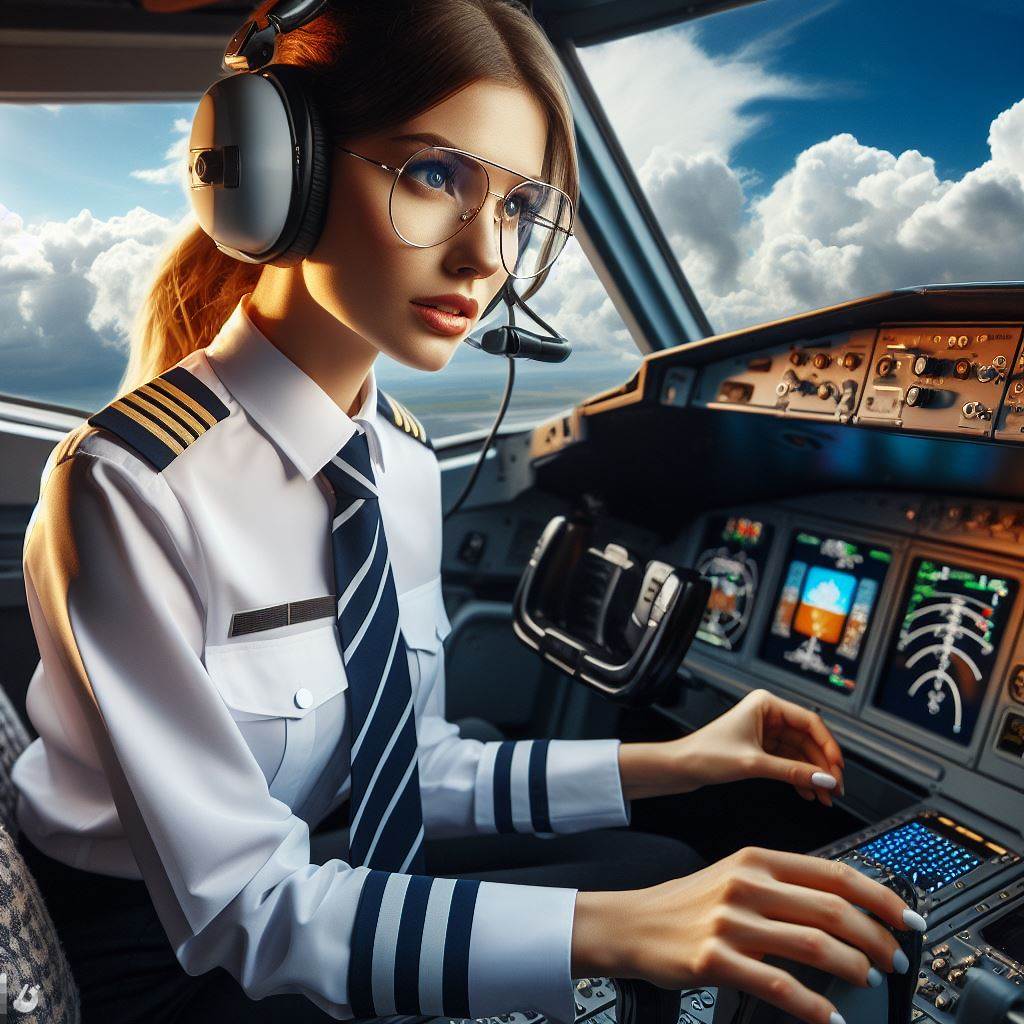Introduction
Navigating the UK’s airspace is a crucial aspect for a pilot to understand and abide by the regulations.
As pilots, we need to have a comprehensive understanding of the intricacies involved in airspace navigation.
It is essential to be familiar with the rules and regulations governing airspace to ensure safe and efficient flight operations.
This knowledge allows us to maintain proper separation from other aircraft and prevent any potential conflicts.
The UK’s airspace is divided into various classes, each with its own set of rules and restrictions.
It is vital for pilots to have a clear understanding of these divisions and the associated requirements.
Furthermore, pilots must be aware of the different types of controlled airspace, such as Terminal Control Areas (TCAs), Control Zones (CTRs), and Military Aerodrome Traffic Zones (MATZs).
Each requires specific communication procedures and compliance with air traffic control instructions.
Understanding the various navigation aids available in the UK’s airspace is another crucial aspect for pilots.
These aids, including VHF omnidirectional range (VOR) stations and distance measuring equipment (DME), assist in accurate positioning and navigation during flights.
In addition to the regulations and aids, pilots need to be aware of special areas within the UK’s airspace.
These include prohibited, restricted, and danger areas, which may have temporary restrictions or hazardous conditions that must be avoided.
By adhering to the regulations, understanding the intricacies of airspace navigation, and being familiar with the various aids available, pilots can navigate the UK’s airspace safely and efficiently.
It is a responsibility we embrace to ensure the smooth operation of air traffic in the country.
Overview of UK Airspace
A general overview of the UK’s airspace
The UK’s airspace is a complex system that is carefully managed to ensure safe and efficient air travel.
Personalized UK Career Consulting
Receive tailored career guidance designed just for you. Get actionable steps and expert support to boost your career in 1-3 days. Take control of your career now.
Get StartedThere are several different classes of airspace, each with its own characteristics and regulations.
Air traffic control plays a crucial role in managing the airspace and ensuring the safe separation of aircraft.
Classes of Airspace
Class A Airspace
This is the highest level of controlled airspace and is typically found around major airports.
Aircraft in this airspace must be under constant radio contact with air traffic control and follow specific routing and altitude instructions.
Class B Airspace
Class B airspace is also controlled, but to a slightly lesser extent than Class A.
It generally covers smaller airports and areas with moderate air traffic.
Pilots in Class B airspace must follow specific instructions and obtain clearance from air traffic control for all operations.
Class C Airspace
Class C airspace is primarily found around smaller airports and is also controlled.
Aircraft in this airspace must establish radio contact with air traffic control, but there are usually fewer restrictions compared to Class A and B.
Class D Airspace
Class D airspace is typically found around smaller airports with less traffic.
While it is still controlled airspace, the requirements for entry and communication with air traffic control are less stringent.
Class E Airspace
Class E airspace encompasses a large portion of the UK’s airspace and is generally uncontrolled.
Pilots are not required to establish radio contact with air traffic control, but it is recommended for situational awareness.
Class G Airspace
Class G airspace is uncontrolled and covers the majority of the UK’s airspace.
Your Dream Job Starts with a Perfect CV
Get a tailored CV and cover letter that captures your unique strengths and stands out in your industry. Let us help you make an unforgettable first impression.
Get StartedPilots have the freedom to operate without the need for communication with air traffic control, but they must maintain vigilance and follow general regulations.
Role of Air Traffic Control
Air traffic control is responsible for managing the flow of air traffic within the UK’s airspace.
They monitor aircraft movements, provide instructions to pilots, and ensure safe separation between aircraft.
Using radar and communication systems, air traffic controllers coordinate the arrival and departure of aircraft at airports, as well as guide aircraft during flights.
Their primary goal is to maintain a high level of safety and efficiency throughout the airspace system.
Overall, air traffic control plays a vital role in safeguarding the UK’s airspace and facilitating the smooth operation of air travel.
By understanding the different classes of airspace and the role of air traffic control, pilots can navigate the UK’s airspace with confidence and ensure safe journeys for all passengers.
Read: UK Pilot Licenses: Types and Requirements
Airspace Structure
The structure of the UK’s airspace and its divisions
In order to understand the complexity of navigating the UK’s airspace, it is essential to first comprehend its structure and divisions.
The UK’s airspace is divided into several distinct regions, each serving a specific purpose.
Controlled and Uncontrolled Airspace
One important aspect of airspace structure is the differentiation between controlled and uncontrolled airspace.
Controlled airspace refers to areas with specific rules and regulations enforced by air traffic control (ATC).
These areas are typically busier and require pilots to obtain permission before entering.
On the other hand, uncontrolled airspace is less restrictive and doesn’t involve direct ATC involvement.
Optimize Your LinkedIn for Success
Boost your LinkedIn profile with a professional bio, keyword-rich headline, and strategic recommendations that attract recruiters. Stand out from the crowd and get noticed.
Optimize NowPilots are responsible for their own separation and must exercise caution to avoid any potential conflicts.
Significance of airways, waypoints, and reporting points in air navigation
Airways, waypoints, and reporting points play a crucial role in air navigation within the UK’s airspace system.
Airways are designated routes that connect major airports and navigation aids.
They are essentially highways in the sky, facilitating efficient and organized air traffic flow.
Waypoints are specific geographic locations or coordinates that serve as reference points for navigation.
They are typically marked by a GPS coordinate or a radio navigation aid.
Pilots use waypoints to plot their course and ensure accurate positioning during their journey.
Reporting points, also known as reporting fixes, are additional reference points used primarily for communication and reporting purposes.
These points are typically located at specific intersections of airways and act as checkpoints for pilots to confirm their position with ATC.
The Significance of Airspace Structure
The airspace structure of the UK is of utmost importance for air navigation efficiency, safety, and communication.
A well-designed structure allows for the smooth flow of air traffic while minimizing the risk of mid-air collisions.
Controlled airspace enhances safety by providing separation services and clear communication between pilots and ATC.
It ensures that aircraft maintain a safe distance from each other, reducing the chances of accidents or near misses.
Uncontrolled airspace, although more flexible, still requires pilots to exercise caution and adhere to established rules.
Pilots must constantly be aware of their surroundings and actively look out for other aircraft to maintain a safe distance.
Airways, waypoints, and reporting points provide a standardized framework for navigation.
They allow pilots to plot their course accurately, ensuring they are on the correct path and minimizing the risk of straying into restricted or prohibited airspace.
In short, understanding the structure of the UK’s airspace is crucial for pilots navigating through it.
The differentiation between controlled and uncontrolled airspace, as well as the utilization of airways, waypoints, and reporting points, all contribute to safe and efficient air travel.
Pilots must adapt to this structure and ensure adherence to regulations to maintain the highest level of safety in the skies.
Read: The Best Flight Schools Across the UK
Airspace Categories
The different categories of airspace in the UK
Class A Airspace
Class A airspace is the highest category, primarily used for commercial airline routes.
It extends from 18,000 feet above mean sea level up to flight level 600 (60,000 feet).
This airspace requires an Instrument Flight Rules (IFR) clearance to enter.
Examples of airports in Class A airspace include London Heathrow and Manchester Airport.
Class B Airspace
Class B airspace is typically found around major airports to accommodate high-density air traffic.
It extends from the surface up to a specified height, usually with multiple layers.
Pilots must obtain clearance from Air Traffic Control (ATC) to enter this airspace.
Luton Airport and Birmingham Airport represent Class B airspace in the UK.
Class C Airspace
Class C airspace is used around airports with moderate air traffic and control tower facilities.
It extends from the surface up to a specified height, often with a circular boundary.
Pilots must establish two-way communication with ATC before entering this airspace.
Examples of Class C airspace are Liverpool John Lennon Airport and Edinburgh Airport.
Class D Airspace
Class D airspace is associated with airports that have control towers for traffic management.
It extends from the surface up to a specified height, usually with a smaller radius than Class C.
Pilots must establish two-way communication with ATC to enter this airspace.
London City Airport and Glasgow Airport fall under the category of Class D airspace.
Class E Airspace
Class E airspace is less controlled and primarily used for instrument flight operations.
It extends from the surface or the base of Class A airspace up to a specified height.
Pilots must follow Instrument Flight Rules (IFR) or Visual Flight Rules (VFR) depending on the airspace.
Leeds Bradford Airport and Bristol Airport are examples of Class E airspace.
Class F Airspace
Class F airspace is airspace not classified as other classes and usually designated for specific activities.
It may have certain restrictions or rules depending on the purpose and time of use.
Examples of Class F airspace include gliding areas or military training zones.
Class G Airspace
Class G airspace is uncontrolled and exists primarily in rural or remote areas.
It extends from the surface up to a specified height, usually below Class E airspace.
Pilots must primarily follow Visual Flight Rules (VFR) and use advisory services when available.
Regions like the Scottish Highlands and the Lake District represent Class G airspace.
Understanding the different categories of airspace is crucial for pilots to navigate safely and efficiently.
Each category comes with specific characteristics and restrictions that pilots must adhere to.
Whether it’s the busy Class B and C airspace around major airports or the vast uncontrolled Class G airspace, pilots must always be aware of their location and the rules applicable to their current airspace.
By following these rules and guidelines, pilots can ensure a smooth and secure flight throughout the UK’s airspace system.
Read: Pilot Salary Trends in the UK for 2024
Air Traffic Control Procedures
Following Procedures
Pilots must adhere to specific procedures while navigating the UK’s airspace for ensuring safety and efficient operations.
The regulations include maintaining proper separation distances, following designated routes, and adhering to speed restrictions.
Continuous monitoring of radio communications, navigation instruments, and adherence to altitude restrictions are also essential.
The Role of Flight Plans and Clearances
Flight plans play a crucial role in the efficient flow of air traffic by providing information about the intended route, altitude, and estimated time of arrival.
Before departure, pilots must file their flight plans, ensuring it aligns with the regulations and guidelines set by the UK’s aviation authority.
Air Traffic Control (ATC) provides clearances, informing pilots of their permitted routes and altitudes, taking into account other air traffic in the vicinity.
Importance of Communication and Following Instructions
Communication with ATC is vital to the safe navigation of the UK’s airspace, enhancing situational awareness and preventing potential conflicts.
Pilots must establish and maintain regular radio contact with ATC, reporting their position, altitude, and intentions.
ATC provides instructions regarding altitudes, course changes, maintaining separation distances, and traffic avoidance.
Pilots should promptly acknowledge and follow these instructions for a well-coordinated and safe flow of air traffic.
Navigating the UK’s airspace requires pilots to follow specific procedures outlined by aviation authorities.
These procedures include maintaining separation distances, adhering to designated routes, and adhering to speed restrictions.
Flight plans are crucial for efficient air traffic flow, and clearances provided by ATC inform pilots about permitted routes and altitudes.
Communication with ATC is of utmost importance, enabling situational awareness and preventing conflicts.
Pilots must establish regular radio contact and promptly follow ATC instructions for safe navigation.
By adhering to these procedures and maintaining effective communication with ATC, pilots play a vital role in ensuring smooth and secure air traffic operations within the UK’s airspace.
Read: How to Become a Pilot in the UK: A Guide

Airspace Restrictions and Special Use Areas
Airspace restrictions in the UK are critical for aviation safety and effective air traffic control.
These restrictions aim to separate different types of airspace users and ensure their safe operation.
The various airspace restrictions in the UK
Here are some examples of airspace restrictions in the UK:
- Controlled Airspace: This airspace is regulated by air traffic control (ATC) and is designated for commercial flights. It includes airports and their immediate vicinity, ensuring a safe flow of air traffic during takeoff, landing, and taxiing.
- Restricted Areas: These areas are established to protect sensitive locations or activities, such as nuclear power plants, military installations, or government buildings. Entry into restricted areas is strictly prohibited unless authorized by the appropriate authority.
- Prohibited Areas: Similar to restricted areas, prohibited areas are strictly off-limits to all aircraft. These zones usually encompass highly sensitive locations like military bases or areas with potential terrorist threats.
- Danger Areas: Danger areas are used for military training exercises or weapons testing. Though aircraft are allowed to fly through these areas, they must exercise extreme caution and adhere to any ATC instructions.
- Temporary Restricted Areas: These areas are created for specific time periods due to events or emergencies. Examples include airspace restrictions during major airshows or during visits from foreign dignitaries.
- National Parks and Wildlife Refuges: Designated natural parks and wildlife refuges often have airspace restrictions to minimize disturbance to the environment or protected wildlife species.
The reasons behind these restrictions
The reasons behind these airspace restrictions are primarily for safety and security:
- Separation of Airspace Users: By dividing airspace into different categories, conflicts between types of aircraft, such as commercial flights and military jets, are minimized. This separation ensures the safety of all airspace users.
- Protection of Sensitive Activities or Locations: Restricted and prohibited areas provide protection to sensitive facilities, infrastructure, and zones that require high-security measures.
- Avoidance of Unauthorized Entry: Airspace restrictions prevent unauthorized aircraft from entering certain areas, reducing the risk of accidental or intentional damage to critical infrastructure.
Examples of special use areas such as military airspace or restricted zones
Special use areas, such as military airspace or restricted zones, are examples of specific airspace restrictions:
- Military Airspace: Military airspace is used for the training of military pilots and the operation of military aircraft. These areas are essential for maintaining a well-prepared and efficient defense force.
- Restricted Zones: Restricted zones may include areas where airports are located, requiring aircraft to adhere to specific regulations and procedures to ensure safe operations around these critical facilities.
In essence, airspace restrictions in the UK play a crucial role in maintaining aviation safety and security.
These restrictions separate different types of airspace users, protect sensitive locations, and ensure the smooth flow of air traffic.
Pilots must have a comprehensive understanding of these restrictions to navigate UK airspace safely and efficiently.
Navigational Aids and Technology
The navigational aids available to pilots for airspace navigation
Navigational aids are crucial for pilots to navigate through the complex UK airspace efficiently and safely.
These aids include radio beacons, such as VOR (Very High Frequency Omnidirectional Range), which provide direction information.
The use of instruments, GPS, and electronic flight bags
Instrument landing systems (ILS) help pilots approach and land safely by providing precise vertical and horizontal guidance.
GPS (Global Positioning System) has revolutionized navigation, offering accurate position data to pilots in real-time.
With GPS, pilots can determine their exact location, track, groundspeed, and altitude, enhancing situational awareness.
Electronic flight bags (EFBs) have replaced traditional paper charts, providing pilots with digital access to navigation charts, airport diagrams, and other important information.
EFBs offer a range of features such as weather updates, NOTAMs (Notice to Airmen), and performance calculations.
In addition to navigation aids, pilots rely on advanced avionics systems that display information on multifunction displays (MFDs).
These displays show airspeed, altitude, heading, and navigation information, allowing pilots to navigate accurately.
The importance of staying updated with technological advancements
Staying updated with the latest technological advancements is crucial for pilots to make the best use of navigational aids.
The aviation industry constantly introduces new technologies to improve navigation accuracy and efficiency.
Pilots must undergo regular training to familiarize themselves with new equipment and stay proficient in their use.
GPS advancements, such as WAAS (Wide Area Augmentation System), provide even higher precision and integrity for navigation.
The integration of ADS-B (Automatic Dependent Surveillance-Broadcast) technology improves aircraft visibility and enhances safety.
Continuous monitoring and upgrading of navigational aids and technology ensure that pilots can confidently navigate the UK airspace.
Pilots must also be aware of potential technology limitations, such as GPS signal loss due to environmental factors or system failures.
It is crucial for pilots to cross-reference information from multiple sources, such as charts and instruments, to ensure accuracy.
Technological advancements in communication, such as data link capabilities, facilitate direct communication between pilots and air traffic control.
This improves efficiency and reduces the risk of miscommunication, enhancing overall flight safety.
As technology continues to evolve, it is essential for pilots to embrace these advancements and adapt to the changing navigation landscape.
In general, navigational aids and technology play a vital role in assisting pilots in navigating the UK airspace.
From traditional radio beacons to advanced GPS and electronic flight bags, these aids enhance situational awareness and ensure accurate navigation.
Staying updated with technological advancements and undergoing regular training are crucial for pilots to utilize these tools effectively.
The continuous improvement and integration of technology contribute to safer and more efficient flights in the complex airspace of the UK.
Challenges and Considerations
Identifying the Common Challenges Pilots May Face when Navigating the UK’s Airspace
- Weather conditions can rapidly change in the UK, posing risks to pilots’ navigation.
- Air traffic congestion is a significant challenge, particularly in busy airports and major cities.
- Pilots need to navigate various types of controlled and restricted airspace, requiring careful planning.
- Unpredictable and intense turbulence can occur over mountainous regions, adding complexity to navigation.
- Poor visibility due to fog, rain, or low clouds hampers pilots’ ability to navigate safely.
Factors Affecting Navigation: Weather, Congestion, and Air Traffic
- The UK’s weather, characterized by frequent rain and strong winds, presents challenges for pilots.
- Congestion in the sky results from the high volume of flights, particularly near major airports.
- Air traffic control manages the flow of aircraft, ensuring safe separation and efficient navigation.
- Weather-related delays can occur, impacting flight schedules and requiring pilots to adjust their routes.
- Navigating around other aircraft requires pilots to maintain situational awareness and constant communication.
The Need for Continuous Training and Maintaining Situational Awareness
Continuous training is crucial for pilots to navigate the UK’s airspace effectively and safely.
Pilots must stay updated on changes in regulations, procedures, and airspace designations.
Regular simulator sessions allow pilots to practice navigation techniques in various challenging scenarios.
Maintaining situational awareness is vital to promptly respond to changes in weather and air traffic.
Using advanced navigation equipment and staying informed through real-time weather updates is essential.
In nutshell, navigating the UK’s airspace poses various challenges for pilots. Weather conditions, congestion, and air traffic require pilots to be highly skilled and adaptable.
Continuous training and maintaining situational awareness are paramount for safe and efficient navigation.
By addressing these challenges and considering external factors, pilots can maneuver the UK’s airspace with confidence.
Conclusion
Navigating the UK’s airspace is a crucial aspect of being a pilot. It requires understanding the rules and regulations and effectively communicating with air traffic control.
To recap, we discussed the different classes of airspace, the importance of proper planning and situational awareness, and the significance of radio communication.
Understanding and navigating the UK’s airspace effectively is essential for the safety of all aircraft and passengers.
Being able to anticipate potential conflicts and adjust flight paths accordingly is vital to prevent accidents and maintain order in the skies.
By staying updated with current regulations and practicing good airmanship, pilots can contribute to the overall efficiency and safety of the airspace system.
We encourage all readers to continue learning and gaining further knowledge about the UK’s airspace.
It is essential to stay informed about any changes or updates in regulations and procedures.
Additionally, consider seeking additional training or attending workshops to enhance your skills and ensure safe flying experiences.
Remember, knowledge is power, and being a well-informed pilot contributes to a safer and more efficient aviation industry.
Fly safe, stay informed, and continue to grow as a pilot. The sky is vast and full of opportunities, but it is our responsibility to navigate it safely and responsibly.
[E-Book for Sale]
500 Cutting-Edge Tech Startup Ideas for 2024 & 2025: Innovate, Create, Dominate
$19.99 • 500 Tech Startup Ideas • 62 pages
You will get inspired with 500 innovative tech startup ideas for 2024 and 2025, complete with concise descriptions to help you kickstart your entrepreneurial journey in AI, Blockchain, IoT, Fintech, and AR/VR.




